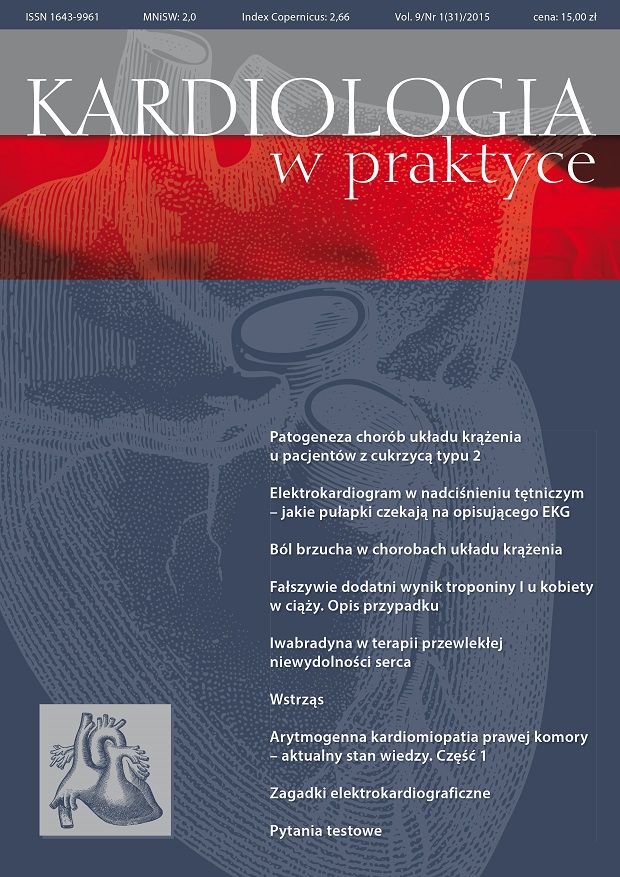Patogeneza chorób układu krążenia u pacjentów z cukrzycą typu 2 Artykuł przeglądowy
##plugins.themes.bootstrap3.article.main##
Abstrakt
Jedną z głównych przyczyn zwiększonej śmiertelności u chorych na cukrzycę są choroby układu krążenia. Do większości zgonów w tej grupie pacjentów dochodzi na skutek zawałów mięśnia sercowego i udarów. Jako najistotniejsze czynniki patogenetyczne chorób układu krążenia wymienia się hiperglikemię, hiperinsulinemię, insulinooporność,dyslipidemię i nadciśnienie tętnicze. Oprócz nich istotne znaczenie dla rozwoju miażdżycy mają: palenie papierosów, podwyższone stężenie homocysteiny, białka C-reaktywnego i fibrynogenu. Przewlekła hiperglikemia i związany z nią nasilony stres oksydacyjny są kluczowymi mechanizmami patogenetycznymi powikłań naczyniowych w cukrzycy. Wolne rodniki tlenowe powodują oksydację lipoprotein, zaburzenia funkcji śródbłonka, nadreaktywność krwinek płytkowych i zaburzenia krzepnięcia krwi. Ustalenie roli tych czynników ryzyka w patogenezie angiopatii cukrzycowej może mieć istotne znaczenie w jej skutecznej terapii.
Pobrania
##plugins.themes.bootstrap3.article.details##

Utwór dostępny jest na licencji Creative Commons Uznanie autorstwa – Użycie niekomercyjne 4.0 Międzynarodowe.
Copyright: © Medical Education sp. z o.o. This is an Open Access article distributed under the terms of the Attribution-NonCommercial 4.0 International (CC BY-NC 4.0). License (https://creativecommons.org/licenses/by-nc/4.0/), allowing third parties to copy and redistribute the material in any medium or format and to remix, transform, and build upon the material, provided the original work is properly cited and states its license.
Address reprint requests to: Medical Education, Marcin Kuźma (marcin.kuzma@mededu.pl)
Bibliografia
2. Ceriello A., Motz A.: Is oxidative stress the pathogenic mechanism underlying insulin resistance, diabetes and cardiovascular disease? The common soil hypothesis revisited. Arterioscler. Thromb. Vasc. Biol. 2004; 24: 816-823.
3. De Vriese A.S., Verbeuren T.J., Van de Voorde J. et al.: Endothelial dysfunction in diabetes. Br. J. Pharmacol. 2000; 130: 963-974.
4. Lin K.Y., Ito A., Asagami T. et al.: Impaired nitric oxide synthase pathway in diabetes mellitus: role of asymetric diethylarginine and dimethylarginine dimethylaminohydrolase. Circulation 2002; 106: 987-992.
5. Cardillo C., Nambi S.S., Kilcoyne C.M. et al.: Insulin stimulates both endothelin and nitric oxide activity in the human forearm. Circulation 1999; 100: 820-825.
6. Stuehlinger M., Abbasi F., Chu J.W. et al.: Close relationship between insulin resistance and endogenous nitric oxide inhibitor. JAMA 2002; 287: 1420-1426.
7. Meigs J.B., Hu F.B., Rifai N. et al.: Biomarkers of endothelial dysfunction and risk of type 2 diabetes mellitus. JAMA 2004; 291: 1978-1986.
8. Tan K.C.B., Chow W.S., Ai V.H.G. et al.: Advanced glycation end products and endothelial dysfunction in type 2 diabetes. Diab. Care 2002; 25: 1055-1059.
9. Vogl-Willis C.A., Edwards I.J.: High glucose induced alterations in subendothelial matrix perlecan leads to increased monocyte binding. Arterioscler. Thromb. Vasc. Biol. 2004; 24: 858-863.
10. UK Prospective Diabetes Study Group: Tight blood pressure control and risk of macrovascular and microvascular complications in type 2 diabetes: UKPDS 38. BMJ 1998; 317: 703-713.
11. Birkenghager W.H., Staessen J.A., Gasowski J. et al.: Effects of antihypertensive treatment on endpoints in the diabetic patients randomized in the Systolic Hypertension in Europe (Syst-Eur) trial. J. Nephrol. 2000; 13: 232-237.
12. Hannson L., Zanchetti A., Carruthers S.G. et al.; The HOT Study Group. Effects of intensive blood pressure lowering and low-dose aspirin in patients with hypertension: principal results of the Hypertension Optimal Treatment (HOT) randomised trial. Lancet 1998; 351: 1755-1762.
13. Chirieac D.V., Chrieac L.R., Corsetti J.P. et al.: Glucose-stimulated insulin secrection supresses hepatic triglyceride-rich lipoprotein and apoB production. Am. J. Endocrinol. Metab. 2000; 279: 1003-1011.
14. Kornerup K., Nordestagaard B.G., Feldt-Rasmussen B. et al.: Transvascular low-density lipoprotein transport in patients with diabetes mellitus type 2. Arterioscler. Thromb. Vasc. Biol. 2002; 22: 1168-1174.
15. Sobel B.E., Woodcock-Mitchell J., Schneider D.J. et al.: Increased plasminogen activator inhibitor type-1 in coronary artery atherectomy specimens from type-2 diabetic compared with nondiabetic patients. Circulation 1998; 97: 2213-2221.
16. Keating F.K., Sobel B.E., Schneider D.J.: Effects of increased concentrations of glucose on platelet reactivity in healthy subjects and in patients with and without diabetes mellitus. Am. J. Cardiol. 2003; 92: 1362-1365.
17. Gresele P., Guglielmini G., de Angelis M. et al.: Acute, short-term hyperglycemia enhances shear-induced platelet activation in patients with type 2 diabetes mellitus. J. Am. Coll. Cardiol. 2003; 41: 1013-1020.
18. Żurawska M., Drzewoski J.: Insulinooporność, zespół metaboliczny, upośledzona tolerancja glukozy i cukrzyca typu 2 konsekwencją procesu zapalnego. Med. Metab. 2004: 7(1): 25-30.
19. Mosca L., Collins P., Herrington D.M. et al.: Hormone replacement therapy and cardiovascular disease: a statement for health professionals from the American Heart Association. Circulation 2001; 104: 499-503.
20. Duell B.P., Malinow R.: Homocysteine, B vitamins, and risk of cardiovascular disease. Heart 2000; 83: 127.
21. Christen W.G., Ajani U.A., Glynn R.J. et al.: Blood levels of homocysteine and increased risks of cardiovascular disease. Arch. Intern. Med. 2000; 160: 422.
22. Bostom A.G., Silbershatz H., Rosenberg I.H.: Nonfasting plasma total homocysteine levels and all-cause and cardiovascular disease mortality in elderly Framingham men and women. Arch. Intern. Med. 1999; 150: 1077.
23. Bostom A.G., Selhub J.: Homocysteine and arteriosclerosis. Circulation 1999; 99: 2361.
24. Miselli M.A., Nora E.D., Passaro A. et al.: Plasma triglycerides predict ten-years all-cause mortality in outpatients with type 2 diabetes mellitus. Cardiovasc. Diabetol. 2014; 13: 135.
